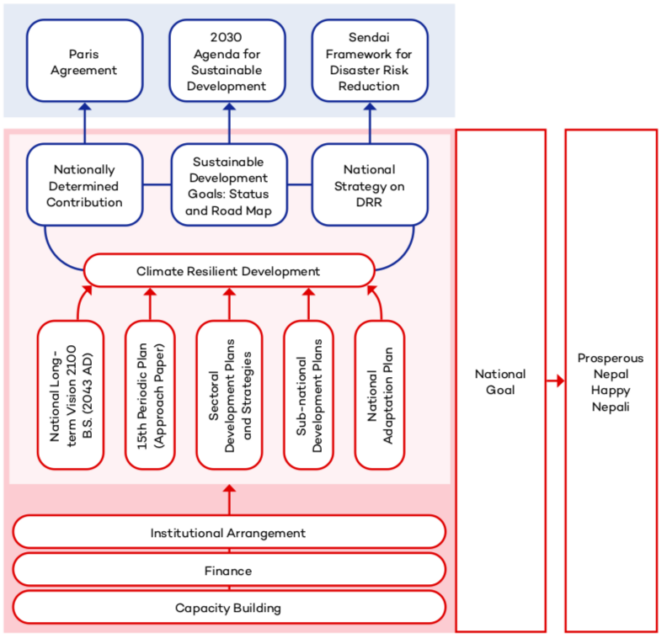Policy alignment to advance climate-resilient development in Nepal: opportunities and way forward

Introduction
Nepal’s political and economic situation has been in a state of transition over the last few years due to major political change. This has led to changes in the entire policy outlook of the country. After promulgation of the country’s new constitution in 2015, different policies to address the pressing needs of the country are being reviewed, including those focused on the impacts of climate change and achieving sustainable development. Recently, the Government of Nepal endorsed the Climate Change Policy 2019 and the Environment Protection Act (with provisions related to climate change) considering the new governance structure of the country. Nepal’s Nationally Determined Contribution (NDC) is currently being reviewed and updated. It is expected that the process will consider the new governance structure of the country and address the many climate risks the country is exposed to. Furthermore, the National Adaptation Plan (NAP) formulation process has been relaunched to identify and address the medium- and long-term adaptation needs of the country.
While the policy processes are rolled out, it is imperative to explore, build and enhance understanding of how they can be strategically aligned to increase the coherence, efficiency and effectiveness of climate action in Nepal. This discussion paper* thus aims to explore potential entry points for increased alignment of policy processes related to the 2030 Agenda for Sustainable Development, the Paris Agreement under the United Nations Framework Convention on Climate Change (UNFCCC) and the Sendai Framework for Disaster Risk Reduction (DRR). It assesses the existing and potential synergies among different policy processes in terms of their objectives and areas of focus, to guide policy-makers in advancing climate-resilient development in Nepal. Because the updating of the policy processes is ongoing, this paper has reviewed the latest draft of those policies to the extent possible.
*Download the full paper from the right-hand column and follow the links below to further reading.
Key messages
Nepal’s policy landscape in 2019: A vision of climate-resilient development
Climate change and associated hazards threaten each of the economic as well as the non-economic and social sectors of Nepal. This is reiterated in the 15th Periodic Plan—a plan considered as a foundation plan to achieve long-term development goals. The 15th Periodic Plan Approach Paper includes a section on climate change that outlines a vision to develop a climate-resilient society through increasing adaptation capacity and mitigating the negative impacts of climate change. The plan also put forward the following objectives:
- Reduce the impacts of climate change as per the Paris Agreement and build adaptive capacity.
- Implement environmentally friendly, clean energy and green development concept for climate change mitigation.
- Access available international finance and technology through the mechanisms under the Paris Agreement for climate change mitigation and adaptation and distribute the funds equitably.
Nepal’s NAP process aims at identifying the medium- and long-term adaptation needs of the country and developing a framework to address those adaptation needs through concrete implementation and financing strategies. The NAP process is gaining momentum with support from the Green Climate Fund and is expected to deliver a NAP document for the country by later in 2020. For this to be achieved, it is imperative to consider the following key priorities:
- evolving the working groups with the new federal governance structure;
- engaging provincial and local governments in the NAP process;
- developing a NAP framework;
- completing the vulnerability and risk analysis;
- compiling and sharing existing information on vulnerability and adaptation;
- expanding stakeholder engagement mechanisms;
- developing a financing strategy;
- and creating an enabling environment for sub-national integration of adaptation.

Institutional arrangements related to climate-resilient development (p.12)
Sustainable Development Goals (SDGs):Three high-level committees have been formed to help implement the SDGs: a steering committee chaired by the prime minister, a coordination committee chaired by the vice-chairman of the NPC and nine thematic committees headed by NPC members.
Disaster risk reduction and management (DRRM): At the national/federal level, the DRRM Act envisions a National Council for DRRM under the chairmanship of the prime minister. At the provincial level, the DRRM Act proposes a provincial disaster management committee chaired by the chief minister, with a District disaster management committee and a local-level disaster management committee.
Climate change:The climate change governance structure in Nepal has three tiers of coordination mechanisms whose scope is different. Two are at the political level chaired by the Prime Minister and government ministers and one is at the executive level composed of state and non-state actors.
Entry points for the alignment of policy processes in Nepal (p.15)
1. Institutional arrangements
Nepal has already set up institutional arrangements for the coordination of climate change, disaster risk reduction and the SDGs. These three themes have been led by three different institutions, namely the Ministry of Forests and Environment, Ministry of Home Affairs and National Planning Commission.
2. Existing synergies in policy documents
Policy coherence should be assessed from national to sub-national to local levels (vertically) and across line ministries and sectors (horizontally). This can help identify the common areas of focus or cross-cutting themes (and approaches adopted) while also improving tracking of the results and/or progress, identification of potential implementation partners, the actors involved and maximizing local resources.
3. Capacity building
Capacity building is important to identify and address policy linkages. More importantly, it supports efficient and effective processes toward climate-resilient development.
4. Information sharing mechanisms
As a party to a variety of national and international policy processes and commitments, Nepal is required to devise, review and update on the progress made in implementing the different elements of the policy processes, including targets outlined for the SDGs, the NDC and DRR. Accomplishing this requires a collection of data that would also serve as a critical element for understanding alignment.
5. Implementation and financing strategies
Aligned implementation of climate, DRR and sustainable development actions at the local and provincial levels needs to be institutionalized within the power-sharing mechanism across the three tiers of the government. The role of the provincial and local governments in implementing different policies should be defined, with a clear mechanism for reporting.
6. Monitoring, evaluation and review
Within the Paris Agreement architecture, Nepal is required to develop a measurement, reporting and verification (MRV) system to effectively implement the NDC goals and targets. The national MRV system can include adaptation, mitigation and finance targets and goals.
Lessons Learnt
The entry points discussed above provide a strong basis for fostering synergies and promoting strategic alignment for effective implementation. In order to have these entry points actually work, seven immediate action points need to be considered to move forward on alignment:
- Form a team within the ministry to start up the alignment process
- Communicate and hold a series of meetings with sectoral ministries, in particular the Ministry of Home Affairs and National Planning Commission
- Review and finalise the NDC in line with other policy processes
- Formulate the NAP along with the implementation strategy
- Establish and operationalize integrated coordination mechanisms at the provincial level
- Foster partnerships for the aligned implementation of the policy processes for climate resilient development
- Promote multi-stakeholder engagement in different policy processes

Comments
There is no contentYou must be logged in to reply.